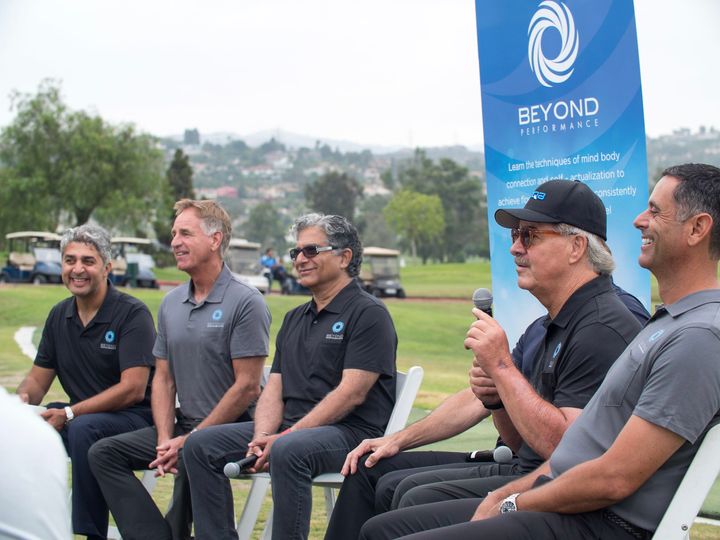
Beyond Performance Sports - Golf Initiative Launch @Omni La Costa, Carlsbad, CA
Deepak Chopra, MD’s ‘Law of Detachment’ has been one of the cornerstones of my life. The essence of this law is that in detachment lies the wisdom of uncertainty . . . in the wisdom of uncertainty lies the freedom from our past, from the known, which is the prison of past conditioning. And in our willingness to step into the unknown, the field of all possibilities, we surrender ourselves to the creative mind that orchestrates the dance of the universe. So how does the “Law of Detachment” apply to sports? Most athletes are so attached to the outcome that the get in their own way of attaining their goals. The elite athletes are those that have mastered the process and detached to the outcome. This is the essence of the ‘Beyond Performance Sports (BPS)’ training program. Can we unlock the potential of the body mind and break the traditional sports training paradigm? Can we bring information, insight and training to athletes of all levels with the goal of not only improving their performance, but even more importantly, creating an environment of affiliation and self-actualization.
Beyond Performance Sports is a blended training program leveraging a psychological skills training program (PST) such as self-efficacy and imagery can be integrated with neural feedback, HRV, meditation and breathing routines for player development. The blended training program integrates meditation and breathing programs to enable player to manage their cognitive and somatic anxiety and emotion regulation.
Self-efficacy is a construct derived from social cognitive theory and describes one’s belief in being able to execute a specific task to obtain a certain outcome (Bandura, 1977,1997). The theory explores how the subjective judgment of what one can do with the skills that he or she posses can influence outcome.
BPS investigates the motivation level of a player and the effort expended on an activity, as well as the emotional reaction in response to failure. Athletes are less troubled by aversive stimuli or failure if they perceive to have control over potential difficult tasks or situations. Mastery and goal imagery ability plays an important role in regulating confidence and the intensity and direction of anxiety symptoms. The relationship between self-efficacy and sport outcomes has been explored in detail across various sports disciplines. This present study examines the effectiveness of a blended training that has integrated technology such as neural feedback, HRV, meditation and breathing routines to enhance the self-efficacy of basketball players.
The BPS program evaluates an athlete/players past performance accomplishments and though a structured process of imaging oneself performing skills and strategies well, or achieving the desired action but not be attached to the outcome, will increase one’s own ability by giving the player a sense that he or she has been successful. A player’s ability to leverage imagery can be used to regulate anxiety by reducing the intensity of symptoms experienced and/or by helping a player to view these symptoms as under control. The program leverages meditation routines (Deepak Chopra, SBTI, 2016) that has imagery scripts containing descriptions of anxiety symptoms and replaces them with feelings of confidence and positive cognitions. This enables a player to leverage coming imagery be in better control of the upcoming competitive performance.
The BPS program also incorporates a neural feedback technology called FocusBand (iFoucsBand, 2017). Neurofeedback training works on the principle of operant conditioning. Operant conditioning states that the human brain will tend to repeat behaviors that have resulted in it receiving a reward in the past. Quiet eye (QE) training has been integrated into the training program. The long duration fixation that occurs just prior to motor response has been called the quiet eye (QE) period and is on the basis of the blended training program. The QE training can be used to train basketball players to maintain a longer QE duration to enhance the free throw shooting outcome. This principle can be leveraged for training baseball pitchers, golfers and across multiple sports disciplines. Understanding the optimal visual search pattern, fixation location, attentional control, and onset of the QE fixation for basketball free throws is an essential element to the training. In addition, training of attentional control using the ‘Beyond Performance Sports’ pre-performance process, has demonstrated improvements in free throw percentage and jump shot performance.
Breathing and HRV training has been integrated into the blended training program to quantify the athlete’s autonomous nervous system. Since the autonomous nervous system plays an important role in exercise training responses, HRV can be used to prevent fatigue and overtraining. HRV is used as part of the ‘Beyond Performance’ training to guide and individualize training load. Also HRV is modulated by respiratory activity (Eckberg, 2003; Penttila et al., 2001). Yogic breathing techniques (pranayama) has been integrated into the program to maximize player performance and prevent fatigue.
Can ’Beyond Performance Sports” be the new paradigm to not only transform the potential of an athlete so that they can reach their zenith, but also enable them to “live in flow”?
References:
· Bandura, A. (1977). Self-efficacy: Toward a unifying theory of behavioral change. Psychological Review, 84, 191–215. doi: http://dx.doi.org/10.1037/0033-295X.84.2.191
· Bandura, A. (1997). Self efficacy: The exercise of control. New York, NY: W.H. Freeman.
· Williams S, Cuming J (2015). Athlete imagery ability: A predictor of confidence and anxiety intensity and direction: doi:http://dx.doi.org/10.1080/1612197X.2015.1025809
· Villani D, Caputo M, Balzarotti S, Riva G. (2015). Enhancing self-efficacy through a blended training: A Pilot study with basketball players doi: http://dx.doi.org/10.1080/161297X.2015.1079921
· iFocusBand (2017). The FocusBand is a wearable brain training headband that measure your brain activity. http://www.ifocusband.com/
· Deepak Chopra, MD, Dr.Tom House, Jason Goldsmith, Dr.Peter Mackay, Dr. James Meschino, Poonacha Machaiah (2017). Beyond Performance Sports, a blended sports training program integrating imaging, neural feedback, HRV, meditation and breathing routines. http://www.jiyo.com/
· Beyond Performance Sports: https://www.facebook.com/beyondperformancesports/
